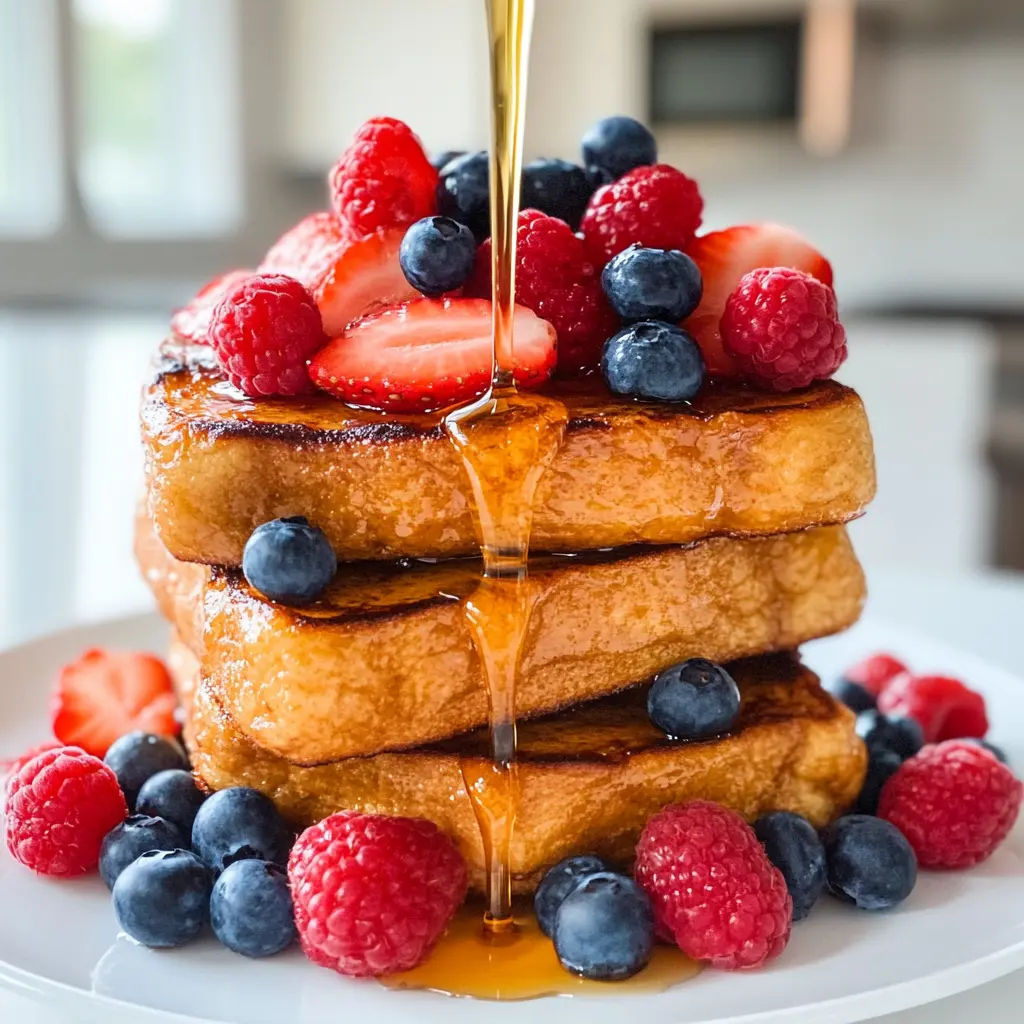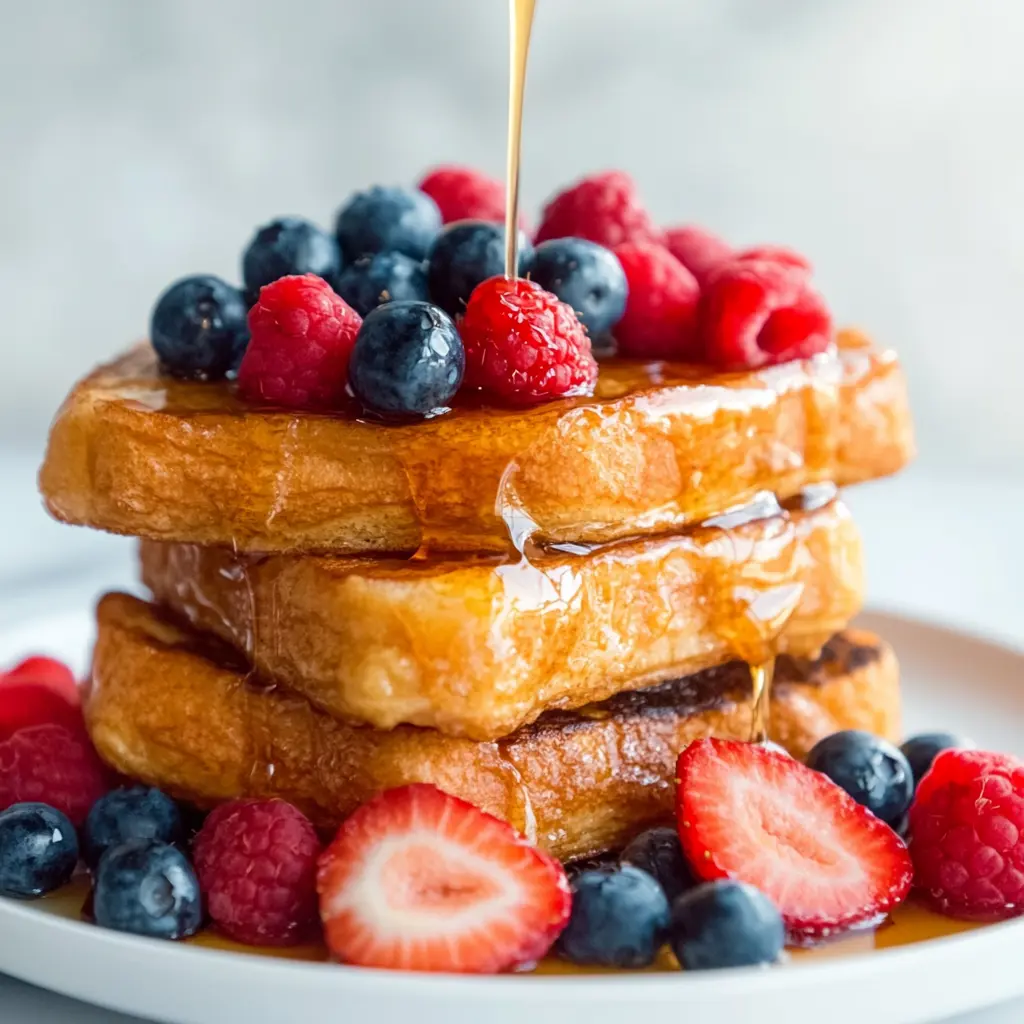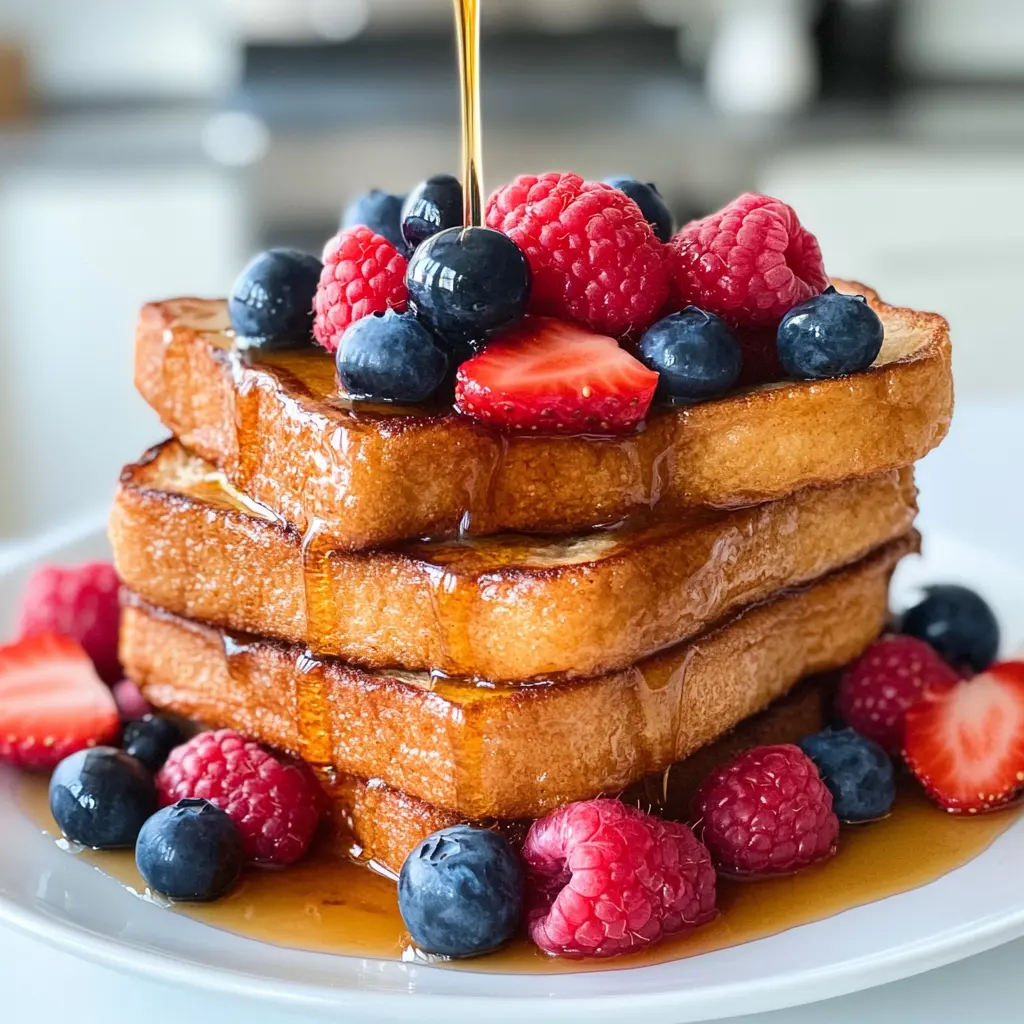Introduction
Gluten-free French toast In recent years, gluten-free diets have gained significant popularity, not just among individuals with celiac disease or gluten intolerance but also among those seeking a healthier lifestyle. This beloved breakfast classic can be easily adapted to meet dietary needs without sacrificing flavor or texture.
It offers a delicious and easy-to-make breakfast or brunch option that caters to those who need to avoid gluten. Whether you’re looking for a comforting breakfast to start your day or a sweet treat for a lazy weekend brunch, it’s a versatile dish that can be customized with various toppings and flavors.
This article will guide you through understanding, preparing, and enjoying the gluten-free version, ensuring you have all the tips and tricks to make the perfect meal every time. So, let’s dive into the world of French toast and discover how to make this delightful dish at home!
Understanding Gluten-Free French Toast
What is Gluten-Free French Toast?
Gluten-free toast is a variation of the traditional French toast, specifically made to be safe for individuals who cannot consume gluten. The main difference lies in the type of bread used. Instead of regular wheat bread, gluten-free uses bread made from alternative flours like rice, almond, or tapioca. This ensures that the dish remains delicious and suitable for those with gluten sensitivities or celiac disease.
Benefits of Gluten-Free French Toast
Choosing gluten-free comes with several health benefits. For individuals with celiac disease or gluten intolerance, avoiding gluten is essential to prevent adverse health effects. Gluten-free provides a tasty alternative that allows them to enjoy a beloved breakfast staple without worry.
Moreover, gluten-free toast can be healthier overall. Many gluten-free breads are made from nutrient-dense ingredients such as almond flour or whole grains, which can offer more vitamins, minerals, and fiber compared to traditional white bread. This can contribute to better digestion and sustained energy levels throughout the day. Additionally, making French toast at home allows for greater control over the ingredients, enabling a reduction in added sugars and unhealthy fats.
Common Ingredients in Gluten-Free French Toast
Creating the perfect gluten-free toast starts with choosing the right ingredients. Here are some common components:
- Gluten-Free Bread Options: There are various types of gluten-free bread available in stores, including those made from rice flour, almond flour, tapioca flour, and sorghum flour. It’s essential to select a bread that holds up well when soaked in the egg mixture to avoid a soggy outcome.
- Batter Ingredients: The batter typically consists of eggs and milk. For those who are also lactose intolerant or prefer dairy-free options, almond milk, coconut milk, or oat milk can be excellent substitutes. Spices like cinnamon and nutmeg, along with a touch of vanilla extract, add delightful flavor to the batter.
- Additional Ingredients: To enhance the nutritional value and taste, consider adding a pinch of salt, a bit of sugar or honey for sweetness, and even some fresh fruit or nuts as toppings.
By understanding these key components, you can create a delicious and nutritious gluten-free French toast that everyone will enjoy.
Preparing Gluten-Free French Toast
Choosing the Right Bread
Selecting the right bread is crucial for making the perfect gluten-free French toast. Here are some tips and options to consider:
- Types of Gluten-Free Bread: There are several varieties of gluten-free bread available, each offering different textures and flavors. Some popular options include:
- Rice Flour Bread: Light and airy, this type of bread is a common choice for those new to gluten-free products.
- Almond Flour Bread: Nutty and rich, almond flour bread provides a denser texture that holds up well in the egg mixture.
- Sorghum Flour Bread: Slightly sweet with a robust texture, sorghum flour bread is another excellent option for French toast.
- Tapioca Flour Bread: Known for its chewiness, tapioca flour bread adds a unique texture to your French toast.
- Tips for Selecting the Best Bread: When choosing gluten-free bread for French toast, consider the following:
- Texture: Look for bread that is firm and slightly dense. Soft, airy bread might fall apart when soaked in the egg mixture.
- Flavor: Choose a bread with a neutral or slightly sweet flavor to complement the sweetness of the French toast batter.
- Freshness: Fresh bread tends to work better as it soaks up the batter nicely without becoming too soggy. However, slightly stale bread can also be used for a firmer texture.
Essential Equipment and Tools
To make gluten-free French toast, you’ll need some basic kitchen tools:
- Mixing Bowls: For preparing the batter.
- Whisk or Fork: To blend the eggs, milk, and spices thoroughly.
- Non-Stick Skillet or Griddle: Ensures even cooking and prevents sticking.
- Spatula: For flipping the French toast slices.
- Measuring Cups and Spoons: To measure ingredients accurately.
- Bread Knife: For slicing the bread, if not pre-sliced.
Basic Gluten-Free French Toast Recipe
Here’s a simple, step-by-step recipe to make delicious gluten-free French toast at home:
Ingredients:
- 4 slices of gluten-free bread
- 2 large eggs
- 1/2 cup almond milk (or any milk alternative)
- 1 teaspoon vanilla extract
- 1 teaspoon ground cinnamon
- 1/4 teaspoon nutmeg
- 1 tablespoon sugar or honey (optional)
- Pinch of salt
- Butter or oil for cooking
Instructions:
- Prepare the Batter: In a mixing bowl, whisk together the eggs, almond milk, vanilla extract, cinnamon, nutmeg, sugar (if using), and a pinch of salt until well combined.
- Heat the Skillet: Place a non-stick skillet or griddle over medium heat and add a small amount of butter or oil.
- Soak the Bread: Dip each slice of gluten-free bread into the batter, ensuring both sides are thoroughly coated but not overly soaked.
- Cook the French Toast: Place the soaked bread slices on the hot skillet. Cook for about 2-3 minutes on each side, or until golden brown and slightly crispy.
- Serve Hot: Serve the French toast immediately with your favorite toppings, such as fresh fruit, nuts, syrup, or a dusting of powdered sugar.
By following these steps and tips, you can create a mouthwatering batch of gluten-free French toast that will impress your family and friends. Enjoy experimenting with different types of bread and ingredients to find your perfect combination!

Variations and Enhancements
Gluten-Free French Toast Variations
Gluten-free French toast is versatile and can be modified to create exciting variations. Here are a few ideas to try:
- Stuffed French Toast: Take your French toast to the next level by adding a delicious filling. Spread a layer of cream cheese, nut butter, or a fruit compote between two slices of gluten-free bread before dipping it in the batter. Cook as usual and enjoy a gooey, flavorful surprise with every bite.
- French Toast Sticks: Perfect for kids or for a fun twist on the traditional dish, French toast sticks are easy to make. Simply cut the gluten-free bread into thick strips before dipping them in the batter. Cook the strips until they are golden brown and serve with a variety of dipping sauces like maple syrup, chocolate sauce, or fruit purees.
Flavor Enhancements and Toppings
Enhance the taste and texture of your gluten-free French toast with these delicious toppings and flavor additions:
- Fruits: Fresh fruits such as berries, banana slices, or apple chunks add natural sweetness and a burst of flavor. You can also try sautéed fruits for a warm, caramelized topping.
- Nuts: Sprinkle toasted nuts like almonds, walnuts, or pecans on top of your French toast for a crunchy texture and added protein.
- Syrups: Traditional maple syrup is a classic choice, but you can also experiment with other syrups like agave nectar, honey, or fruit syrups.
- Spices: Enhance the flavor of your batter with additional spices. Try adding a pinch of cardamom, cloves, or ginger to the mix for a unique twist.
- Dairy-Free and Vegan Options: For a dairy-free version, use almond milk, coconut milk, or oat milk. You can also substitute eggs with flaxseed meal or chia seeds mixed with water to create a vegan-friendly batter.
These variations and enhancements ensure that your gluten-free French toast is always exciting and delicious. Mix and match different toppings and flavors to discover your favorite combinations.
Serving and Enjoying Gluten-Free French Toast
Perfect Pairings for Gluten-Free French Toast
To create a well-rounded and delightful meal, pair your gluten-free French toast with complementary beverages and side dishes:
- Beverages:
- Coffee: A rich, aromatic cup of coffee pairs wonderfully with the sweet flavors of French toast.
- Tea: Herbal teas like chamomile or mint provide a refreshing contrast, while spiced chai adds a complementary warmth.
- Smoothies: Blend fruits, greens, and dairy-free milk to create a nutritious smoothie that complements your French toast.
- Side Dishes:
- Bacon or Sausages: These savory options add a deliciously salty balance to the sweet French toast. Opt for gluten-free sausages or turkey bacon for a healthier choice.
- Fresh Fruits: A bowl of mixed berries, sliced bananas, or citrus fruits enhances the meal with natural sweetness and a refreshing touch.
- Yogurt: A dollop of Greek yogurt or dairy-free yogurt provides creaminess and a protein boost, perfect for a balanced breakfast.
Tips for Serving
Enhance your gluten-free French toast presentation and ensure it remains warm until served with these tips:
- Presentation Ideas:
- Stacked and Layered: Stack the French toast slices neatly on a plate, layering with fruit slices or spreads in between for a visually appealing presentation.
- Garnishes: Add a sprinkle of powdered sugar, a drizzle of syrup, or a few fresh mint leaves on top for a polished look.
- Colorful Plates: Use colorful plates and bowls to make the meal visually vibrant and inviting.
- Keeping French Toast Warm:
- Oven Method: Place cooked French toast on a baking sheet in a preheated oven at a low temperature (around 200°F) to keep them warm while you finish cooking the rest.
- Cover with Foil: If you’re serving a large batch, cover the French toast with aluminum foil to retain heat without drying it out.
By pairing your gluten-free French toast with the right beverages and sides, and serving it with attention to detail, you can create a memorable and delightful breakfast or brunch experience for yourself and your guests.
Troubleshooting and FAQs
Common Issues and Solutions
Making gluten-free French toast can come with its own set of challenges. Here are some common issues and how to solve them:
- Soggy French Toast:
- Issue: The French toast turns out too soggy and lacks the desired crispiness.
- Solution: Use slightly stale gluten-free bread, as it absorbs the batter without becoming overly saturated. Ensure your skillet or griddle is preheated properly before cooking to create a nice, crispy exterior.
- Burnt French Toast:
- Issue: The French toast burns on the outside while remaining undercooked inside.
- Solution: Cook the French toast on medium heat. If the heat is too high, the outside will cook too quickly, leaving the inside underdone. Additionally, avoid overcrowding the pan, which can affect the cooking temperature.
FAQs
- How to store and reheat gluten-free French toast?
- Storage: Allow the French toast to cool completely before storing it in an airtight container. It can be kept in the refrigerator for up to three days.
- Reheating: Reheat the French toast in a toaster oven or conventional oven at 350°F until warmed through. Avoid microwaving, as it can make the toast soggy.
- Can I make French toast with other gluten-free bread alternatives?
- Yes, you can experiment with various gluten-free bread alternatives such as:
- Cornbread: Adds a sweet and slightly crumbly texture.
- Potato Bread: Provides a denser and hearty texture.
- Buckwheat Bread: Offers a nutty flavor and firm texture, ideal for French toast.
- Yes, you can experiment with various gluten-free bread alternatives such as:
- How do I make gluten-free French toast dairy-free?
- To make your French toast dairy-free, substitute the milk in the batter with a plant-based alternative like almond milk, coconut milk, or oat milk. Use a dairy-free butter or oil for cooking. Ensure all other ingredients, such as the bread, are also dairy-free.
By addressing these common issues and questions, you can ensure your gluten-free French toast turns out perfectly every time and meets any dietary needs you may have.

Conclusion
Creating a delicious and satisfying breakfast doesn’t have to be challenging, even when adhering to dietary restrictions. Gluten-free French toast offers a perfect solution for those who need to avoid gluten but still crave a classic, comforting breakfast or brunch dish. With the right ingredients, tools, and techniques, you can enjoy a flavorful and nutritious meal that everyone will love.
Throughout this article, we’ve delved into the world of gluten-free French toast, exploring its benefits, ingredients, and preparation methods. From understanding what gluten-free French toast is and its health advantages, to choosing the best gluten-free bread and making various delightful versions, you now have a comprehensive guide to mastering this dish.
We’ve also discussed essential equipment and provided a basic recipe to get you started. Additionally, we explored exciting variations like stuffed French toast and French toast sticks, along with numerous flavor enhancements and toppings to customize your meal. Pairing your French toast with complementary beverages and side dishes can elevate your breakfast experience, making it even more enjoyable.
Moreover, troubleshooting common issues ensures your French toast turns out perfectly every time. Addressing FAQs helps you store, reheat, and adapt the recipe to meet other dietary needs, like dairy-free options.
By following these tips and techniques, you can confidently prepare delicious gluten-free French toast that meets any dietary requirements and satisfies your taste buds. Whether you’re cooking for yourself, family, or friends, this versatile and easy dish is sure to become a favorite in your breakfast repertoire.
So why not give these recipes a try? Whether you’re cooking for yourself or for loved ones with dietary restrictions, gluten-free French toast is a versatile, easy, and delicious option that’s sure to please. Happy cooking and enjoy your meal!
Troubleshooting and FAQs
Common Issues and Solutions
Making gluten-free French toast can come with its own set of challenges. Here are some common issues and how to solve them:
- Soggy French Toast:
- Issue: The French toast turns out too soggy and lacks the desired crispiness.
- Solution: Use slightly stale gluten-free bread, as it absorbs the batter without becoming overly saturated. Ensure your skillet or griddle is preheated properly before cooking to create a nice, crispy exterior.
- Burnt French Toast:
- Issue: The French toast burns on the outside while remaining undercooked inside.
- Solution: Cook the French toast on medium heat. If the heat is too high, the outside will cook too quickly, leaving the inside underdone. Additionally, avoid overcrowding the pan, which can affect the cooking temperature.
FAQs
- How to store and reheat gluten-free French toast?
- Storage: Allow the French toast to cool completely before storing it in an airtight container. It can be kept in the refrigerator for up to three days.
- Reheating: Reheat the French toast in a toaster oven or conventional oven at 350°F until warmed through. Avoid microwaving, as it can make the toast soggy.
- Can I make French toast with other gluten-free bread alternatives?
- Yes, you can experiment with various gluten-free bread alternatives such as:
- Cornbread: Adds a sweet and slightly crumbly texture.
- Potato Bread: Provides a denser and hearty texture.
- Buckwheat Bread: Offers a nutty flavor and firm texture, ideal for French toast.
- Yes, you can experiment with various gluten-free bread alternatives such as:
- How do I make gluten-free French toast dairy-free?
- To make your French toast dairy-free, substitute the milk in the batter with a plant-based alternative like almond milk, coconut milk, or oat milk. Use a dairy-free butter or oil for cooking. Ensure all other ingredients, such as the bread, are also dairy-free.
- Can I freeze gluten-free French toast?
- Yes: Place cooked and cooled French toast slices on a baking sheet in a single layer and freeze until solid. Transfer to a freezer-safe bag or container. Reheat in a toaster or oven without thawing for a quick breakfast.
- What toppings work best with gluten-free French toast?
- Fresh fruits, nuts, syrups, and dairy-free yogurt are excellent options. You can also experiment with savory toppings like avocado or a fried egg for a unique twist.
By addressing these common issues and questions, you can ensure your gluten-free French toast turns out perfectly every time and meets any dietary needs you may have.



